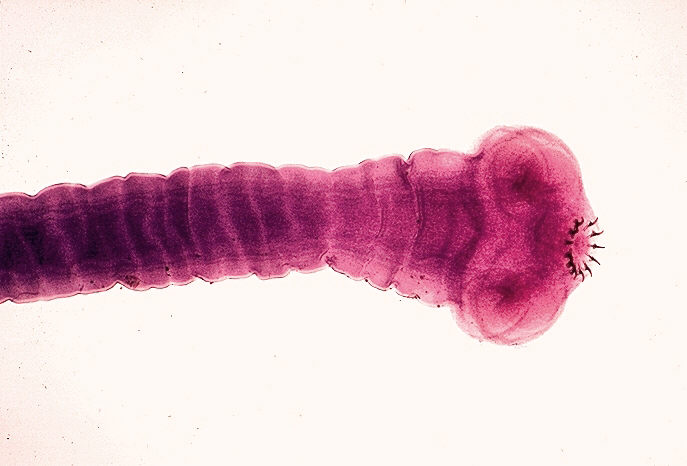- Pork tapeworm
Taxobox
name = "Taenia solium"

image_width = 200px
image_caption = Scolex of "Taenia solium"
regnum =Animal ia
phylum =Platyhelminthes
classis =Cestoda
ordo =Cyclophyllidea
familia =Taeniidae
genus =Taenia
species = "T. solium"
binomial = "Taenia solium"
binomial_authority = Linnaeus, 1758"Taenia solium", also called the
pork tapeworm , is acyclophyllid cestode in the familyTaeniidae . It infectspig s and humans inAsia ,Africa , thePhilippines ,South America , parts ofSouthern Europe , and pockets ofNorth America . Like all cyclophyllid cestodes, "T. solium" has four suckers on itsscolex ("head"). "T. solium" also has two rows of hooks."T. solium" has a very similar life cycle to "Taenia saginata ,". Cysticerci has three morpholocially distinct types. The common one is the ordinary "cellulose" cysticercus which has a fluid filled bladder that is 0.5cm to 1.5 cm in length and an invaginated scolex. The intermediate form has a scolex while the "racemose" has no evident scolex but are believed to be larger and much more dangerous. They are 20cm in length and have 60ml of fluid and 13% of patients might have all three types in the brain. Though humans usually serve as a definitive host, eating infected meat, fostering adult tapeworms in the intestine, and passing eggs throughfeces , sometimes a cysticercus (alarva sometimes called a "bladder worm") develops in the human and the human acts like anintermediate host . This happens if eggs get to thestomach , usually as a result of contaminated hands, but also ofvomiting . Cysticerci often occur in the central nervous system, which can cause major neurological problems likeepilepsy and even death. The condition of having cysticerci in one's body is called "Cysticercosis ," and is discussed in its own article.Eggs can be diagnosed only to the
family (biology) level, but if aproglottid 'suterus is stained withIndia ink , the number of visible uterine branches can help identify the species: unlike the "Taenia saginata " uteri, "T. solium" uteri have only five to ten uterine branches on each side.Infection with "T. solium" adults is treated with
niclosamide , which is one of the most popular drugs for adult tapeworm infections, as well as for fluke infections. As cysticercosis is a major risk, it is important to wash one's hands before eating and to suppress vomiting if a patient may be infected with "T. solium". If Neurocysticercosis occurs the drug of choice isPraziquantel . This drug damages the parasites skin internally causing it to disintegrate and is then removed by the host's immune system.Infection may be prevented with proper disposal of human feces around pigs, cooking meat thoroughly, and/or freezing the meat at -10oC for 5 days. Most cases occur because infected food handlers contaminate the food.
Life cycle
This infection is caused by ingestion of eggs shed in the feces of a human tapeworm carrier. Pigs and humans become infected by ingesting eggs or gravid proglottids. Humans are infected either by ingestion of food contaminated with feces containing eggs, or by autoinfection. In the latter case, a human infected with adult T. solium can ingest eggs produced by that tapeworm, either through fecal contamination or, possibly, from proglottids carried into the stomach by vomiting. Once eggs are ingested, oncospheres hatch in the intestine, invade the intestinal wall, and migrate to striated muscles, as well as the brain, liver, and other tissues, where they develop into cysticerci. In humans, cysts can cause serious
sequelae if they localize in thebrain , resulting inneurocysticercosis . The parasite life cycle is completed, resulting in human tapeworm infection, when humans ingest undercooked pork containing cysticerci. Cysts evaginate and attach to the small intestine by theirscolex . Adult tapeworms develop, (up to 2 to 7 m in length and produce less than 1000 proglottids, each with approximately 50,000 eggs) and reside in the small intestine for years.Geographic distribution
"Taenia solium" is found worldwide. Because pigs are intermediate hosts of the parasite, completion of the life cycle occurs in regions where humans live in close contact with pigs and eat undercooked pork. Taeniasis and cysticercosis are very rare in predominantly
Muslim countries, as Islam forbids the consumption of pork. It is important to note that human cysticercosis is acquired by ingesting T. solium eggs shed in the feces of a human T. solium tapeworm carrier, and thus can occur in populations that neither eat pork nor share environments with pigs.External links
* [http://www.taeniasolium.unam.mx] Taenia solium Genome Project - UNAM
* [Dooley, J.F. 1980.] Health precautions in Mexico. Letter to the editor. J.A.M.A 243:1524.
* [Flisser, A. 1988. Neurocysticercosis in Mexico. Parasitol. Today4:131-137.
* [Rabiela, M.T.,A. Rivas, and A.Flisser. 1989. Morphological types of Taenia "solium" cysticerci. Parasitol. Today5:357-359.
Wikimedia Foundation. 2010.
